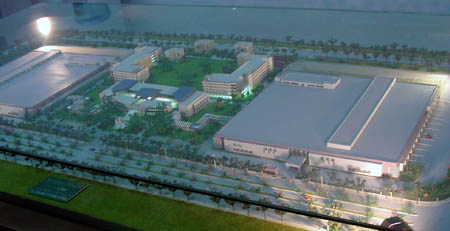The Birth of an Abit NF7 - A Factory Tour
by Kristopher Kubicki on June 11, 2004 10:12 PM EST- Posted in
- Motherboards
Introduction
Last year, we took the opportunity to travel with EliteGroup (ECS) and take an in-depth tour of their production facilities. On that tour, we had the chance to see PCB and motherboard assembly, as well as system building and testing. After receiving such warm response from that article, we jumped all over the opportunity to visit Abit's Chinese production facilities.Although motherboards in and of themselves are quite fascinating, the underlying political struggle between China and Taiwan lays the framework for a more interesting modern issue. As we mentioned in last year's ECS factory tour, political indifference between Taiwanese and Chinese governments prohibit Taiwanese companies from investing large amounts of money into Chinese assests; this includes factories, warehouses, etc. Traditionally, companies like Abit simply incorporate the factory as a completely autonomous corporation. Abit uses the corporation, ANCO (now ANCO-Rolly), to outsource production of their motherboards. Even though ANCO-Rolly is a separate corporate entity, they can best be described as Abit's near exclusive business partner for production. Corporations like Rolly operate constantly in sync with Abit, selling assembled boards back to the Taiwanese company at cost. On paper, these companies are technically and completely unaffiliated with each other, but off the record, they behave together like a single conglomerate.
More recently, companies like TSMC have contested Taiwan's limitations on factories in China, but it will be some time before we see smaller companies like Abit make such leaps.
Rolly (pronounced like "Raleigh") sits across the street from ASUS' Chinese production facilities, and down the street from Canon's assembly plant in the Jiansung providence. Even though people commonly claim that these factories are located in Shanghai, they are actually about an hour west of the city in the industrial work district, called Suzhou. Like Shen Zhen, Suzhou is a special city inside China where companies like Abit and Canon are allowed to practice more capitalistic business practices not typically sanctioned in communist China.

A model of the factory
Click to enlarge.
The plant was built in 1999 with Compaq when Abit received a contract to produce components for Compaq in Southeast Asia. Rolly has 12 SMT lines, about average for a production facility of this size. Most of the practices adopted by the factory in 1999 were revolutionary at the time. Compaq, one of the most conservative and diligent OEMs at the time, worked with Abit to set up one of the most stringent QA programs in the motherboard industry. For those who follow Abit's track record closely, around late 1999/early 2000, Abit's quality in motherboards increased tremendously.










19 Comments
View All Comments
KristopherKubicki - Sunday, June 13, 2004 - link
Got it, thanks.Kristopher
kalaap - Sunday, June 13, 2004 - link
"This is actually the second over on the production line; the first is used right after SMT."I think you meant second OVEN.
AtaStrumf - Sunday, June 13, 2004 - link
Right Click --> Save Target As... ---> save to disk and play from there. If its still not working you need a new player. Real One Player is preety good.roostercrows - Sunday, June 13, 2004 - link
can someone tell me which video players you guys use? i couldn't get my realplayer to download the videos. thanksDonB - Sunday, June 13, 2004 - link
"...why there are more women than men". Women have much better manual dexterity than men. Remember typing classes in high school? I remember in my class, after the first semester, the females were typing around 40-50 wpm while the males were typing around 25-35 wpm, almost without exception.CurtOien - Sunday, June 13, 2004 - link
"The machine technician and the traditional visual inspectors are paid about the same; usually around $100 per month with lodging."I wonder how much the executives make?
AtaStrumf - Sunday, June 13, 2004 - link
The problem that I see with their testing procedure is that they probably only test at default settings, which is just not good enough for an enthusiast targeted motherboard. Sure my KT7 A worked fine at 100 MHz FSB, but it didn't at 133 MHz FSB, and my latest AN7 works fine at default BIOS setting, but when you change something strange things start to happen.I understand that they're in a hurry, but they should at least test at the most stressful settings that the mobo is supposed to function properly i.e. 200 MHz FSB and not 133 or. 166 MHz. What good is a 24 h burn-in test if it's done at 133 MHz FSB, and I'm gonna be using a 200 MHz FSB.
For instance this AN7 that I have now, works perfectly if I OC my 2500+ with the default offered 3200+, but if I change the FSB manualy to 200 its totaly unstable. How strange is that?
KristopherKubicki - Sunday, June 13, 2004 - link
artifex: I have not heard that reason for using women over men in facilities.What other economic information were you interested in? I can add it to the article.
Kristopher
artifex - Sunday, June 13, 2004 - link
I couldn't get the n7_fail image to load (ironic), but other than that, everything was good.Is it still true that another reason why there are more women than men on the assembly line is because womens' hands are generally thought to be smaller, and more adept?
I'd like to see more of the background economic information like what you provided for this story, next time you do a plant tour, too.